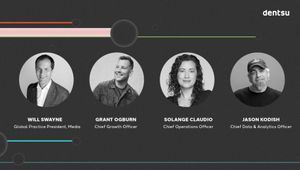
Dentsu Consumer Navigator: LGBTQ Representation in Ads & Entertainment

The dentsu Navigator helps marketers navigate the complexities of understanding consumer behaviour in today's changing world. Dentsu’s monthly surveys of US consumers reveal timely insights on cultural trends, social issues, and emerging industry innovations from gaming to sustainability. These actionable reports empower marketers to make smarter business decisions, stay competitive, and authentically connect with consumers across a range of industries.
As each report launches, LBB will speak to dentsu’s Jack Boitani, VP, content, and Megan Keane, VP, integrated strategy, who work closely together on each report, to find out more about what they discovered.
Please check out and download the full report here.

Q> Why are we focusing on this topic now?
A> LGBTQ inclusion is always an important topic for marketers and advertisers looking to reflect and celebrate the experiences of all people. And, as up-and-coming generations embrace fluid notions of identity, it is a topic that will reflect the experiences of more people. At the same time, politicised voices have grown louder and more divisive. Brands must block out the noise and seek guidance in manifesting their core brand values and in understanding their consumer base. We hope this report can play a role in illuminating the latter.
Q> What are you trying to explore with this report?
A> With this report, our goal is to let consumer sentiment lead the way in influencing how the media and advertising industries approach LGBTQ representation. Our survey found that 55% of Americans believe entertainment and media companies have a responsibility to increase visibility and inclusion of LGBTQ people in their content, and 52% hold the same expectation of brands. Throughout the report consumers tell us LGBTQ stories not only resonate among members of the community but connect with people more broadly. For companies ready to invest in LGBTQ representation, our report provides a roadmap to get started, straight from consumers.
Q> What consumer insight surprised you the most?
A> A striking finding from our survey is which media spaces LGBTQ respondents feel are most inclusive and least inclusive. Social media stood out as the most inclusive space to respondents. While social media can be a place of misinformation, it is also one of community. For LGBTQ youth especially, social media can act as a lifeline to receive information and meet other people like them.
Movies (77%), music (73%) and TV shows (72%) were also recognised by respondents as notably inclusive spaces. Not only does entertainment like music have a uniquely powerful connection to the LGBTQ community, but that connection also emphasizes the importance of visibility and inclusive representation to uplift the queer population.
On the other end of the spectrum, only 48% of LGBTQ respondent find gaming welcoming. Sports lags even further, with just 38% feeling the same. There is a real imperative to design solutions that make media spaces more inclusive for all.
Q> What’s the most important lesson for brands to take coming from this data?
A> If brands take two things away from our report, it should be this:
1. If the effort is inconsistent, it will come across as inauthentic. Authenticity is paramount, and marketers must assess their companies’ willingness to wholeheartedly champion LGBTQ representation. The data underscores the importance of commitment, emphasising that inconsistency can breed inauthenticity. Over two in five consumers feel that for advertisements featuring LGBTQ people or characters to be authentic, the brand also needs to show up IRL for the community. Marketing with conviction necessitates a deep alignment of the cause with brand values and the integration of this commitment as a central marketing imperative. Take Nike. When featuring Colin Kaepernick as the face of their 2018 Dream Crazy campaign sparked backlash, Nike didn’t pull the ad or walk away from Kaepernick. Instead, they leaned in further with additional activations.
2. We must push to capture the full spectrum of the LGBTQ experience. Championing LGBTQ inclusion also means pushing for quality of representation over quantity. While almost half of survey respondents say they frequently see ads featuring LGBTQ people, they also report that those characters tend to fit into more 'accepted' norms: men and women rather than transgender or non-binary people, gay characters rather than ones who are lesbian or bisexual, and mainly white people rather than Black, Hispanic, AAPI, or Native American people. While increasing representation is positive, it is crucial to ensure that the stories we as an industry tell accurately depict the diverse experiences of these communities. Marketers and advertisers must push for more inclusive and authentic portrayals, embracing intersectional identities and non-stereotypical stories.















